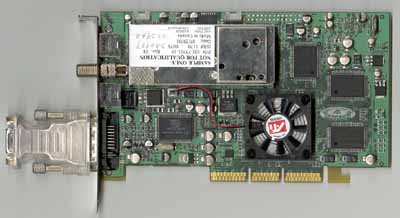ATI All-in-Wonder Radeon 32MB DDR
by Matthew Witheiler on August 21, 2000 3:00 AM EST- Posted in
- GPUs
The Card Part I
Placing a TV tuner on a video card that is already quite packed required a bit of engineering. For ATI, this meant that the reference design for the Radeon would have to be smashed just a bit in order for the large TV tuner to fit. By altering the location of the BIOS, many power regulating components, and one RAM chip, ATI was able to make room for the TV tuning box, enclosed in a metal shield (more on that later). The card features the same Rage Theater chip present in the regular Radeon cards, a chip that allows for both video output as well as input. The Rage Theater chip has always received praise in the lab for providing both excellent video-out as well as very high quality video-in. The chip found on our All-in-Wonder Radeon proved to be no exception.
The first thing that struck us about the All-in-Wonder Radeon, besides the large TV tuner, was what appeared to be only a DVI-out video connector. ATI was quick to inform us that the connector was, in fact, a DVI-I connector that is able to display to not only DVI flat panels but also to standard CRT's with the use of a dongle. Sure enough, a bit of rummaging through the box revealed clear DVI-I to VGA dongle, capable of changing the digital only output to a standard analog connector. ATI states the the reason for switching to a DVI-I only solution is due to the fact the DVI market is growing extremely rapidly in Asia, with many computer users and OEM builders already using DVI only displays. By including a small dongle, ATI was able to appeal to both the DVI dominated market of Asia and the VGA market of the US and Europe, while also making good use of the precious retail space available on the All-in-Wonder Radeon. The truth of the matter is that the All-in-Wonder Radeon could not have made use of both a DVI and VGA connector due to space restrictions on the board. Rather than making two reference designs, one for VGA user and one for DVI users, the DVI-I and dongle solution must have proved to be quite attractive. In addition, this puts the Radeon's on-die TMDS to good use
Like one configuration of the popular Radeon card, the All-in-Wonder Radeon we reviewed was outfitted with 32MB of Samsung DDR SGRAM. Unlike the standard Radeon, however, the All-in-Wonder Radeon will only be available in 32MB configurations due to cost concerns. Since the 32MB Radeons use 6ns Samsung chips, while the 64MB card uses 5.5ns Hyundai DDR SDRAM, the shipping clock speed of not only the All-in-Wonder Radeon but also all 32MB Radeons is actually lower than the shipping clock speed of the 64MB Radeon. The 32MB cards come clocked at 166/166 MHz (166/333 MHz effective) due to the 6ns rating of the RAM chips, compared to the 183/183 MHz (183/366 MHz effective) speed rating on the 64MB Radeons. ATI decided to ship the core with the same speed as the memory . Since the core of the 32MB cards is no different than the core of the 64MB cards, almost every 32MB Radeon core should be able to hit 183 MHz quite reliably, but this may not be the same case for the Samsung memory. How did our All-in-Wonder Radeon card, which contains essentially the same components as a 32MB Radeon card, perform? Check out both the benchmarks as well as the overclocking section to find out.
As far as RAM options, ATI has other plans for the All-in-Wonder's memory solution, including both an SDR model as well as a 16MB DDR configuration. While the SDR model may prove attractive to retail consumers on a budget, the 16MB solution will most likely prove to be an OEM only option. Also look for a PCI version of this card in coming weeks, providing yet another option for i810 and BX-133 owners.











0 Comments
View All Comments